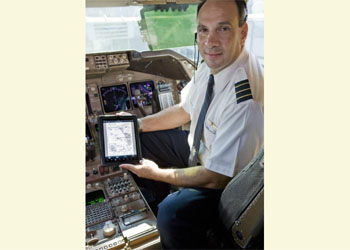United Airlines’ Paperless Flight Deck with iPad
United Continental Holdings says it is converting to paperless flight decks and deploying 11,000 iPads to all United and Continental pilots. The electronic flight bags (EFB) replace paper flight manuals and provide pilots with paperless aeronautical navigational charts through an iPad app.
Distribution of iPads began earlier this month, and all pilots will have them by year end.
“The paperless flight deck represents the next generation of flying,” said Captain Fred Abbott, United’s senior vice president of flight operations. “The introduction of iPads ensures our pilots have essential and real-time information at their fingertips at all times throughout the flight.”
The iPads are loaded with Jeppesen Mobile FliteDeck, an app featuring interactive, data-driven enroute navigation information and worldwide geo-referenced terminal charts. The enhanced full-color, high-quality information display ensures the right information is displayed at the right time, says United.
Each iPad, which weighs less than 1.5 pounds, will replace approximately 38 pounds of paper operating manuals, navigation charts, reference handbooks, flight checklists, logbooks and weather information in a pilot’s flight bag.
A conventional flight bag full of paper materials contains an average of 12,000 sheets of paper per pilot. The green benefits of moving to EFBs are two-fold—it significantly reduces paper use and printing, and, in turn, reduces fuel consumption.
The airline projects EFBs will save nearly 16 million sheets of paper a year which is equivalent to more than 1,900 trees not cut down. Saving 326,000 gallons of jet fuel a year reduces greenhouse gas emissions by 3,208 metric tons.
With iPad, pilots are able to quickly and efficiently access reference material without having to thumb through thousands of sheets of paper and reduce clutter on the flight deck.
United and Continental pilots’ work will be streamlined as they can immediately download updates on iPad to their electronic flight materials, rather than waiting for paper updates to be printed and distributed.
In addition, by eliminating bulky flight bags loaded with paper, pilots will have less to lift and carry through airports and onboard the aircraft, reducing the risk of injury while on duty.





